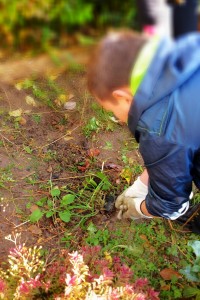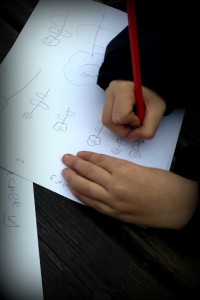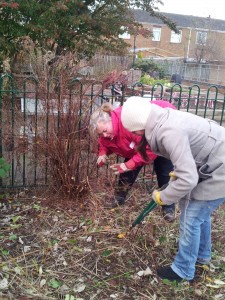- After the Summer break your garden might be looking a little overgrown. Weed around plants that are still OK and clear away the rest (put into compost pile) make sure you harvest all the Summer crops.
- Prune Blackcurrant bushes.
- Investigate what type of soil you have using the soil worksheet and get pupils to research what it might mean for your garden.
- Cut out pictures from magazines to stick in a scrapbook of ideas for the school garden.
October
- Harvest Pumpkins and other vegetables that are not hardy before the first frost arrives.
- Decorate the Pumpkins for Halloween and use the seeds in art and craft work. Measure their weight and girth when you harvest them and keep a record.
- Pick apples and Autumn fruiting Raspberries
- Order fruit canes and bushes (bare rooted are cheaper than container grown fruit.
- Plant garlic cloves, over winter onion sets and cane fruit.
November:
- Keep planting fruit canes and bushes, but make sure the ground is not frozen or water logged.
- Harvest leeks and Kale.
- Start looking for containers you can adapt for use in the garden and decorate them as an indoor activity. Just make sure you put holes in the bottom for drainage.
- Spread manure on any empty beds to improve the soil, if you do it now, it will give the worms a chance to work on it over Winter.
- If you don’t already have one- set up a compost pile, so that you can recycle all garden waste.
December:
- Plant some Rhubarb.
- Harvest leeks, maincrop carrots and Brussels Sprouts.
- Create some bird boxes, bat boxes and insect hotels as a refuge for animals during the cold weather.
- Clean your tools- it is important that they are maintained so they remain good quality tools, now is the time to clean them while they will not be used as often and before the growing season really kicks off again.
- Dig over and rake an area you would like to cultivate
- Start your planning and preparation for a new garden (or to improve and old one) this month- get pupils involved in drawing up some plans and think about what you would like to grow. If you have lots of work to do, why not get the local community involved and let them volunteer.
- Start to order your seeds ready to plant in spring- this could mean that you have the seeds you want before they start to sell out in the shops.
- Harvest winter vegetables and continue to plant fruit trees and bushes up to February.
- Sow onion seeds this month. Sow them in small modules and leave on a windowsill to plant out in March
- Put a stake in next to Brussels Sprouts that are at risk of blowing over in the wind.
- Start ordering seed potatoes and start saving egg boxes ready to chit your potatoes next month.
- Remove all fruit still hanging from the trees- this will be the main cause of any rot on the trees during the coming season.
- Wrap pots and containers in fleece, straw or blankets to protect them from the frost.
- Check the condition of all the stakes and ties in your garden, replace any that might need it and add more where you think they might be needed.
- Protect fruit bushes and canes with netting or fleece if the birds are damaging new buds.
- Hang fat balls on trees and make bird feeders to hang out- this might stop the birds from feeding on your crops and encourage them to eat some of the pests in your garden. You should also provide some un frozen water for the birds to drink.
- Remove any fallen leaves that are sitting on low growing plants, as this can attract pests.
February:
- Chit potatoes this month, and you can plant them next month. Early potatoes should be ready before the end of the Summer Term. Place the seed potatoes in a light, cool frost free area- stand them in egg boxes to do this!
- Start collecting some items to recycle and reuse in the garden and design some creative ways you could use them
- Sow Lettuce and broad beans indoors, Broad Beans are quite hardy so can be planted out in early Spring.
- If you have Autumn fruiting Raspberries, cut all canes back to soil level- new canes will grow in a few weeks time (it is these that will bear the fruit)
- Work out where you could fit some new herbs, as most of the flowering has stopped; it is easier to see where you might be able to fit some. Try to choose herbs that will attract pollinating insects- Hyssop, Sage and Thyme are popular with these creatures.
- Create new paths or pond areas, but avoid treading on wet soil as this will compact it and make it difficult for plants to grow.
- Shake off any heavy snow on low growing herbs.
- Continue to harvest winter Veg.



